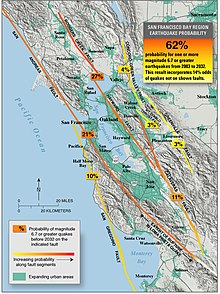This is an old revision of this page, as edited by RockBandit (talk | contribs) at 07:39, 4 May 2005 (Retyping more sections to simplify them and CORRECT erroneous facts.). The present address (URL) is a permanent link to this revision, which may differ significantly from the current revision.
Revision as of 07:39, 4 May 2005 by RockBandit (talk | contribs) (Retyping more sections to simplify them and CORRECT erroneous facts.)(diff) ← Previous revision | Latest revision (diff) | Newer revision → (diff)
An earthquake prediction is a prediction that an earthquake of a specific magnitude will occur at a specific location and time. Seismologists are not currently able to predict earthquakes with such accuracy, instead they focus on calculating the seismic hazards of a region and the probabilities that a given earthquake will occur.
Trying to predict earthquakes
Earthquakes were once thought to be random geologic events without cycles or patterns. In some ways, earthquakes behave similar to the stock market, or types of events in nature that have properties described by chaos theory.
However, like stocks, the pattern of earthquakes is quite capable of being correlated with anything, sometimes based on only one observation. Humans have tried to associate the onset of an earthquake with such things as animal behavior, weather conditions, and the water level in wells.
Parkfield, California
Some types of earthquake predictions do not have to be ultra precise in magnitude, time and place to be socially useful. Predictions of a general nature can be quite useful if they are based on scientific principles.
For example, the region near the town of Parkfield in California has experienced a magnitude 6 earthquake approximately every 22 years since 1857. This led researchers to predict that a similar quake would hit the region between 1988 and 1992. As a result of this prediction, the area around Parkfield was heavily instrumented with monitoring equipment in order to record this event and researchers hoped any data collected would help in unlocking the secret of predicting future earthquakes.
However, the predicted earthquake failed to materialize on the expected fault, though a sizable quake did occur in nearby Coalinga, California in 1983. Some researchers believe the Coalinga quake may have released some of the stress on San Andreas Fault near Parkfield, and was a substitute for the missing quake.
If that was the case, then one would have expected that the next quake in the Parkfield region would be sometime in the mid 2000s. Another earthquake did in fact occur near Parkfield, this time in San Simeon, California in December 2003, but like the Coalinga earthquake in 1983, this quake was also not located on the San Andreas Fault. Regrettably, two fatalities were recorded in the town of Paso Robles as a result of strucure failure during the shaking.
On September 28, 2004, the expected Parkfield earthquake finally occurred. However, data returned has not yielded as much information as researchers had hoped.
Other predictions
In early 2004, a group of scientists at the University of California, Los Angeles, lead by Dr. Vladimir Keilis-Borok, predicted that a quake similar in strength to the San Simeon earthquake would occur in a 12,000 square mile (31,100 km) area of Southern California by September of that year.
In April 2004, the California State Office of Emergency Services formally endorsed the prediction made by Kellis-Borik that there would be a strong earthquake in the Southern California region. The expected earthquake never occurred.
Based on the the historic record of the various published efforts to predict a quake, it might be easy to conclude that earthquake prediction is usually an imprecise, but nonetheless scientifically and socially useful art.
External links
- The USGS view on earthquake prediction http://www.geophys.washington.edu/SEIS/PNSN/INFO_GENERAL/eq_prediction.html
- A study on Tide-Forming Forces and Earthquakes was published 1967 by Elsevier, but the U.S. Geological Survey: Common Myths About Earthquakes contradicts this study.